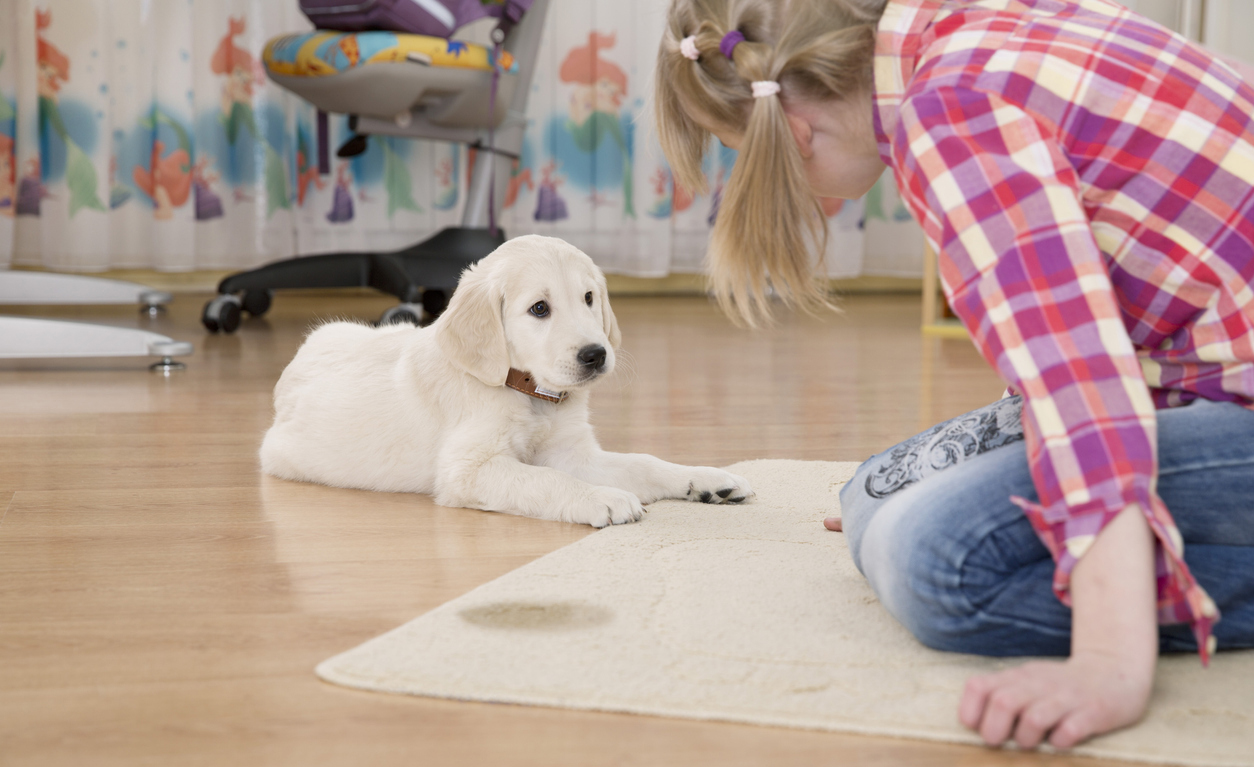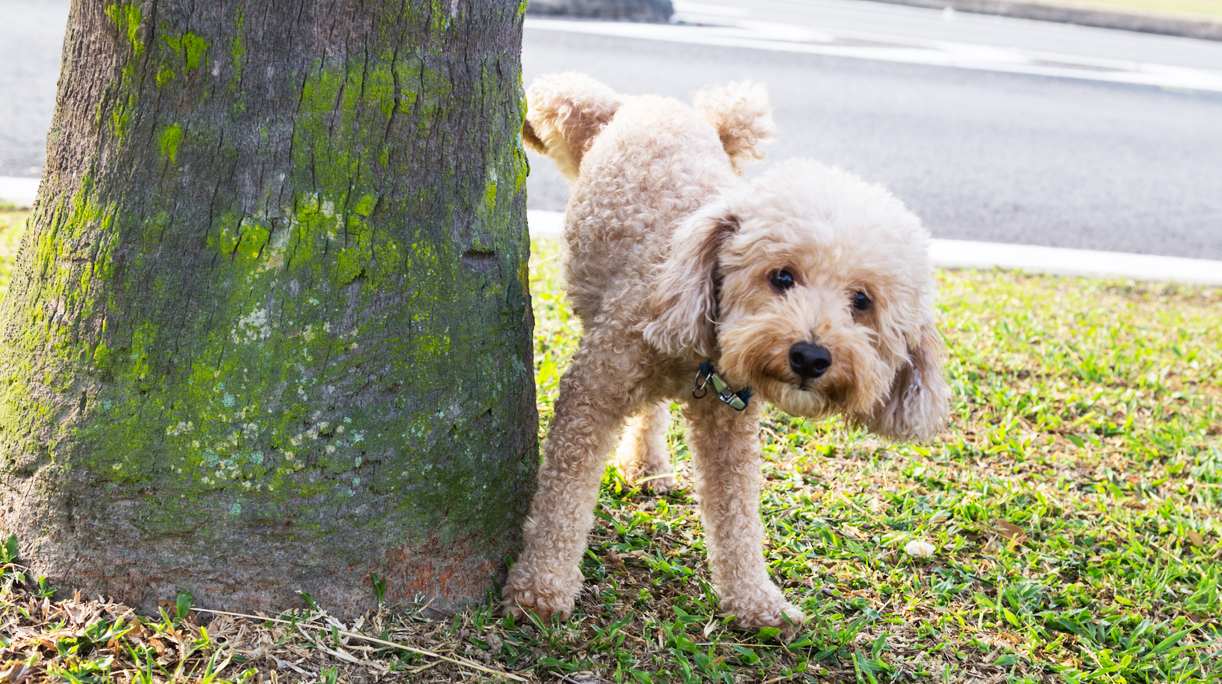Will neutering your puppy stop them from marking in the house? This is the question we will answer as we look at the relationship between marking and having your dog neutered.
Will my dog urinate in the house after being neutered?
There is a difference between urinating and marking, and neutering may only help if your male dog is marking. Marking is when a dog intentionally urinates on the spot to mark its territory. On the other hand, urinating is when your dog relieves their bladder.
Since marking is only something a male dog should begin doing when their hormones are kicking in, it is unlikely that a puppy is marking.
An adult, unneutered male will typically lift his leg to mark, usually smelling the area first. There may only be a small amount of pee, and it is usually against something vertical, like a wall.
Occasionally, they may do it out of frustration, such as peeing on your bed if you have been gone a long time. Typically, a dog marks if he is new territory, or if a strange new animal is close by. Neutering does typically reduce this behavior.
However, if your dog is urinating in the house, and you don’t believe they intend to mark their territory, several possible causes and solutions exist. Usually, when a dog urinates indoors, it’s down to poor house training.
Your first step is to assess whether your dog needs retraining. If your dog isn’t fully house-trained, you can read our article on Puppy Still Not House-trained: Age expectations.
Training an adult dog can be challenging, depending on the breed and its associated temperament.

Will my dog mark in the house after being neutered?
Marking in the house after being neutered depends on how old your puppy is when they are castrated. If your dog has marked in the house for months or years, it is less likely that neutering alone will make the problem go away. That is because after marking for a while, your dog has formed a habitual behavior.
For dogs neutered at a late age, marking may be reduced, but will still probably happen when your dog is stressed or aggravated, such as if there is a strange dog hanging around outside.
That often comes as a surprise to first-time dog owners. It is a commonly held belief that a neutered dog doesn’t mark. However, because the behavior goes beyond hormones and may even be instinctive, the behavior won’t always just stop. That is true regardless of whether or not the associated hormones are present.
Puppies neutered at a young age, especially before puberty will rarely have marking become a problem.
You might also be interested in knowing if your puppy will bark more after neautering.
How does neutering stop a dog from marking in your house?
Males
In male dogs, territorial marking is an instinctive behavior that is ‘activated’ when their bodies start producing male sex hormones. The hormones, or androgens, are responsible for several aspects of a male dog’s behavior.
One of the most observable behaviors associated with male sex hormones is aggression, especially towards other male dogs. The male dog’s marking behavior ties into that aggression as it all stems from a territorial drive to deter sexual competitors.
When a dog gets neutered, their body doesn’t produce the androgens responsible for that behavior anymore. Therefore many of the associated behaviors fall away. That includes the territorial drive to mark their territory,
Females
Female dogs mostly use markings to communicate territorial messages. For example, these messages can indicate that a female is on heat. Like males, most of the markings that an intact female makes communicate information regarding reproduction and territory.
These behaviors are closely linked to the female dog’s hormones, especially when she enters heat and during pregnancy. When a female dog gets spayed, all of the hormonal imperative she had to communicate through marking is lost. Of course, marking is different for females than it is for males, as they are not lifting their legs to claim territory.

How do you stop a neutered dog from marking territory in your house?
As with most things, the best cure is prevention. By having your dog neutered before they reach the age when they start marking, you can save yourself a lot of trouble. However, that is not always possible.
You may have adopted an adult, unneutered dog, or perhaps you have chosen to hold off on neutering your puppy for other reasons. Whatever the reason, you might find that your dog is long past the age where neutering will prevent marking. Nevertheless, there are still some steps you can take.
1. Determine the trigger
As long as your dog isn’t marking every inch of the house, something, or somewhere, triggers it. Identifying a specific trigger, such as a spot, will inform how you address the problem.
For instance, it may be the neighbor’s cat coming for a daily visit or it may be a new male dog in your household. In either situation, it is best to control your dog’s environment and remove the stressor. Another option is to crate your dog if the stressor is temporary.
2. A specific spot
If your dog focuses on marking a specific spot or in a specific room, the first thing you should do is try to restrict access. Then, if possible, keep your dog away from that area.
Next, you want to clean the spot thoroughly. The marking instinct can get triggered by the smell of a previously marked spot. Because dogs have a very keen sense of smell, it’s important to clean the spot with a purpose-made cleaning solution.
After the spot is clean, you can use a potty training aid, such as a no-go potty training spray, to deter your dog from marking the area again. In addition, you can use a ‘go-here’ potty training spray to assist in training your dog to go to a designated spot.
3. New stuff
New items like furniture, appliances, and decor can put your dog in the marking mindset. It can be a challenge limiting your dog’s access to new things in the house. Avoiding a nasty surprise means vigilance, and you will have to monitor your dog around the new thing closely.
Dog’s peeing on the furniture is a common occurrence.
A deterrent spray may help, but if your dog is adamant, it will take direct intervention to stop them from laying claim to your new couch. On the other hand, if you can keep them from marking it, your dog should learn to ignore the new thing as the novelty wears off.
4. Sneaky strangers
There could be another reason that your dog marks inside. Unseen visitors, particularly strange dogs that come too close to your home, can trigger your dog’s marking instincts. The solution here is less about stopping the behavior and more about addressing the situation.
A dog should receive proper socialization throughout their lives, which usually prevents this behavior. But, if the unfamiliar dogs are marking territory on or around your property, you can’t blame your dog for trying to bolster their claim to the house.
Unsupervised dogs pose a risk, and if possible, you should identify the owners of the dogs and ask them to help find a solution to the problem. If the dogs in question are strays, you must contact animal control or a similar NPO.
It doesn’t always feel great doing so, but stray dogs pose a risk to neighborhood animals, children, and property. It’s the responsible thing to do.
5. Medical mimicry
There is always the possibility that your dog is not marking at all. Some medical conditions relating to the urinary tract and bladder can cause behavior that mimics marking. Fortunately, there are distinctions between the behaviors.
The ‘markings’ won’t usually occur in the same spot. Your dog doesn’t think about how the behavior looks to you. If their body tells them to do something in response to a medical condition, they won’t put much thought into it.
If you suspect that your dog might have a medical condition that has them ‘marking’ in or around the house, you must schedule an appointment with your vet. Such infections can start pretty mild but can worsen if they go untreated.
Medical conditions like UTI and bladder stones can lead to small amounts of urine being eliminated within the home. This can be mistaken for poor potty training or marking behavior. It is important to realize that this behavior is not being done on purpose because of bad behavior, but secondary to discomfort from an underlying cause. Your veterinarian will be able to help you determine if the urine is a result of marking, a medical condition or potentially poor house training. Dr Marti DudleyVeterinarian Comment
How long after neutering will dogs stop marking their territory in the house?
We know that neutering isn’t a miracle cure to marking. Just how effective it will depend on how old your dog is and whether or not that has already started marking inside your home.
If the marking started shortly before your dog got neutered, the behavior might disappear straight away. However, if your dog was marking for months or years before they got neutered, they are unlikely to stop once neutered. Or it may take around two months for all the hormones to leave their system if the behavior isn’t too ingrained.
That is because marking is an instinct fueled by hormones and triggered by things in the dog’s environment. The only way the marking will stop once it’s become a thing is through intervention and training.
Do belly bands stop a dog from marking?
Depending on how you use them, belly bands are either a short-term aid or a training tool. They are not a final solution. However, there are some great belly bands that you can use to train your dog not to mark.
The idea is that the belly band sits on the dog so that when they mark, they end up wetting only themself. Naturally, the dog does not think that this is a fun outcome and eventually stops marking altogether,
While belly bands can be effective, they don’t work for every dog. Therefore, it would be best to be vigilant about when you have them on your dog and when you take them off. Otherwise, the belly belt could disrupt your dog’s potty routine.
Belly bands allow urine to be in contact with the skin. If not changed quickly, this could leak to urine scald. Additionally, dermatitis and ascending urinary tract infections may occur. All these conditions can cause significant discomfort to your pet. If you elect to use a belly band, or a diaper, care must be taken to frequently change the materials to avoid these complications. Dr Marti DudleyVeterinarian Comment
Why is my female dog marking in the house?
When we think of dogs marking, we think of male dogs marking their territory. However, the behavior is not exclusive to male dogs. Female dogs engage in marking behavior, but often it is for different reasons than male dogs.
Females also convey territorial messages, particularly when they are in heat. That said, even a spayed female can still mark to communicate, and you should be able to follow the markings to determine their reasons.
An intact female will likely stop marking after she gets spayed. If she doesn’t, the reason is probably related to anxiety. Ideally, one will address the source of her anxiety and address it.
However, sometimes a dog’s anxiety is purely psychological. In that case, you may have to speak to your vet about prescribing your dog anti-anxiety medications to treat the symptoms, including the marking behavior.
Summary
In short, neutering your puppies before puberty should stop marking behavior indoors. Often, what looks like marking might actually be a medical or a house training issue, so it is vital to know what you are dealing with.
If your dog is neutered late in life, marking may always be a problem. This is especially true if your dog is stressed, threatened, or faced with a new environment. There are several steps, including belly bands, that you can try in these situations, but being aware of your dog’s triggers and managing their environment may become part of everyday life.




